Joseph Miranda | |
|---|---|
| Nationality | American |
| Occupation | Game designer |
| Part of a series on |
| Wargames |
|---|
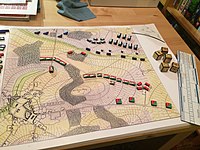 |
Joseph Miranda is an American game designer who has worked primarily on board games.
Joseph Miranda | |
|---|---|
| Nationality | American |
| Occupation | Game designer |
| Part of a series on |
| Wargames |
|---|
 |
Joseph Miranda is an American game designer who has worked primarily on board games.
Joseph Miranda is the editor of Strategy & Tactics magazine and has designed over 100 published wargames. [1] Miranda has also worked for various computer game design firms including HPS Simulations and Hexagon Interactive. [1] He is a former U.S. Army officer who has taught unconventional warfare topics at the JFK Special Warfare Center, and more recently has developed courses in terrorism and Middle Eastern conflict for Chapman University. [1] He has been a featured speaker at the USAF Connections simulations conference, the Military Operations Research Society, and the Origins national wargaming convention. [1]

A wargame is a strategy game in which two or more players command opposing armed forces in a simulation of an armed conflict. Wargaming may be played for recreation, to train military officers in the art of strategic thinking, or to study the nature of potential conflicts. Many wargames re-create specific historic battles, and can cover either whole wars, or any campaigns, battles, or lower-level engagements within them. Many simulate land combat, but there are wargames for naval, air combat, and cyber as well as many that combine various domains.

James F. Dunnigan is an author, military-political analyst, Defense and State Department consultant, and wargame designer currently living in New York City.

Miniature wargaming is a form of wargaming in which military units are represented by miniature physical models on a model battlefield. Miniature wargames are played using model soldiers, vehicles, and artillery on a model battlefield, with the primary appeal being recreational rather than functional. Miniature wargames are played on custom-made battlefields, often with modular terrain, and abstract scaling is used to adapt real-world ranges to the limitations of table space. The use of physical models to represent military units is in contrast to other tabletop wargames that use abstract pieces such as counters or blocks, or computer wargames which use virtual models. The primary benefit of using models is immersion, though in certain wargames the size and shape of the models can have practical consequences on how the match plays out. Models' dimensions and positioning are crucial for measuring distances during gameplay. Issues concerning scale and accuracy compromise realism too much for most serious military applications.

A military exercise, training exercise, maneuver (manoeuvre), or war game is the employment of military resources in training for military operations. Military exercises are conducted to explore the effects of warfare or test tactics and strategies without actual combat. They also ensure the combat readiness of garrisoned or deployable forces prior to deployment from a home base.

Frank Chadwick is an American game designer and New York Times best selling author. He has designed hundreds of games, his most notable being the role-playing games En Garde!, Space: 1889 and Twilight 2000, and the wargame series Europa and The Third World War, as well as creating Traveller with Marc Miller. He has won multiple awards for his work.

Computer Bismarck is a computer wargame developed and published by Strategic Simulations (SSI) in 1980. The game is based on the last battle of the battleship Bismarck, in which British Armed Forces pursue the German Bismarck in 1941. It is SSI's first game, and features turn-based gameplay and two-dimensional graphics.

John Evans Hill was an American designer of military board wargames, as well as rules for miniature wargaming. He is best known as the designer of the Avalon Hill board game Squad Leader and the American Civil War miniatures game Johnny Reb. He was inducted into the Charles Roberts Awards Hall of Fame.

Military simulations, also known informally as war games, are simulations in which theories of warfare can be tested and refined without the need for actual hostilities. Military simulations are seen as a useful way to develop tactical, strategical and doctrinal solutions, but critics argue that the conclusions drawn from such models are inherently flawed, due to the approximate nature of the models used.
Phil Barker is one of the major figures in the development of the modern hobby of tabletop wargaming, particularly that of ancient warfare, and is a co-founder of the Wargames Research Group.

Renaissance of Infantry, subtitled "Tactical Warfare, 1250 A.D.–1550 A.D.", is a board wargame published by Simulations Publications in 1970 that simulates famous medieval battles.

Steel Panthers II: Modern Battles is a 1996 computer wargame developed and published by Strategic Simulations. It is the sequel to Steel Panthers and the second entry in the Steel Panthers series. The game was designed by Gary Grigsby and Keith Brors.

Tyrone S. Bomba is a prolific American board wargame designer, credited as the designer of over 125 board wargames and game items. Bomba is the recipient of the James F. Dunnigan Award, has been inducted into the Charles Roberts Awards Hall of Fame for his contributions to the wargaming industry, and several of his games have won Charles S. Roberts Awards.

Overrun! is a 1989 computer wargame designed by Gary Grigsby and published by Strategic Simulations.
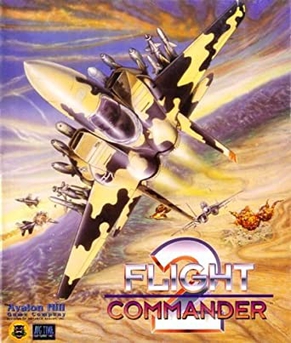
Flight Commander 2 is a 1994 computer wargame developed by Big Time Software and published by Avalon Hill. It was designed by Charles Moylan.
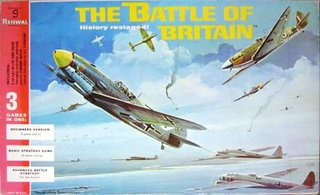
The Battle of Britain is a board wargame published by Gamescience in 1968 that is a simulation of the Battle of Britain during World War II.

Island War: Four Pacific Battles is a collection of four board wargames published in 1975 by Simulations Publications Inc. (SPI) that simulates various battles between American and Japanese forces during the Pacific Campaign of World War II.
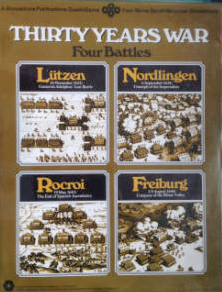
Thirty Years War, subtitled "Four Battles", is a "quadrigame" — four separate board wargames packaged in one box that use a common set of rules — published by Simulations Publications Inc. (SPI) in 1976. The four games simulate different battles during the Thirty Years' War, and were sold individually as well as in the quadrigame format. Some of the games were well received by critics, but overall, the quadrigame did not sell well.

U.S.N.: The Game of War in the Pacific, 1941–43 is a board wargame published by Simulations Publications Inc. (SPI) in 1971 that simulates two years of the Pacific Campaign during World War II.
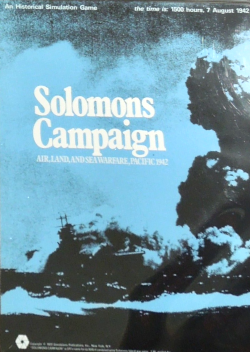
Solomons Campaign, subtitled "Air, Land, and Sea Warfare, Pacific 1942", is a board wargame published by Simulations Publications Inc. (SPI) in 1973 that simulates the struggle between the U.S. and Japan for control of Guadalcanal Island during the Pacific Campaign of World War II.

IJN, subtitled "A Tactical Game of Naval and Naval-Air Combat in The Pacific, 1941–1945," is a board wargame published by Simulations Canada in 1978 that simulates various naval encounters during the Pacific Campaign of World War II. It was the first in a series of three interlocking naval wargames.